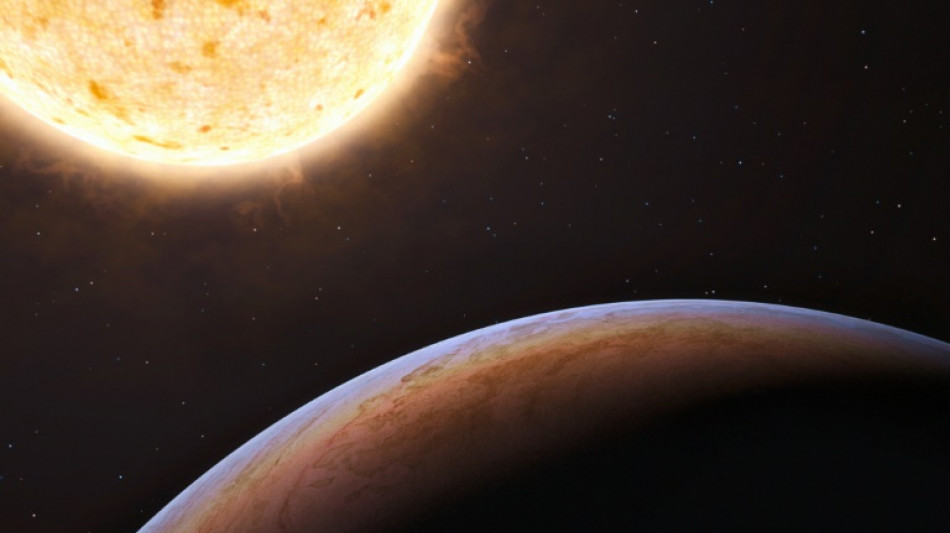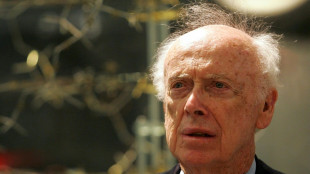
-
 Owners of collapsed Dominican nightclub formally charged
Owners of collapsed Dominican nightclub formally charged
-
US accuses Iran in plot to kill Israeli ambassador in Mexico

-
 New Zealand 'Once Were Warriors' director Tamahori dies
New Zealand 'Once Were Warriors' director Tamahori dies
-
Hungary's Orban wins Russian oil sanctions exemption from Trump

-
 More than 1,000 flights cut in US shutdown fallout
More than 1,000 flights cut in US shutdown fallout
-
Turkey issues genocide arrest warrant against Netanyahu

-
 Countries agree to end mercury tooth fillings by 2034
Countries agree to end mercury tooth fillings by 2034
-
Hamilton faces stewards after more frustration

-
 World's tallest teen Rioux sets US college basketball mark
World's tallest teen Rioux sets US college basketball mark
-
Trump pardons three-time World Series champ Strawberry

-
 Worries over AI spending, US government shutdown pressure stocks
Worries over AI spending, US government shutdown pressure stocks
-
Verstappen suffers setback in push for fifth title

-
 Earth cannot 'sustain' intensive fossil fuel use, Lula tells COP30
Earth cannot 'sustain' intensive fossil fuel use, Lula tells COP30
-
Wales boss Tandy expects Rees-Zammit to make bench impact against the Pumas

-
 James Watson, Nobel prize-winning DNA pioneer, dead at 97
James Watson, Nobel prize-winning DNA pioneer, dead at 97
-
Medical all-clear after anti-Trump package opened at US base

-
 Sabalenka beats Anisimova in pulsating WTA Finals semi
Sabalenka beats Anisimova in pulsating WTA Finals semi
-
Iran unveils monument to ancient victory in show of post-war defiance

-
 MLS Revolution name Mitrovic as hew head coach
MLS Revolution name Mitrovic as hew head coach
-
Brazil court reaches majority to reject Bolsonaro appeal against jail term

-
 Norris grabs pole for Brazilian Grand Prix sprint race
Norris grabs pole for Brazilian Grand Prix sprint race
-
More than 1,200 flights cut across US in govt paralysis

-
 NFL Cowboys mourn death of defensive end Kneeland at 24
NFL Cowboys mourn death of defensive end Kneeland at 24
-
At COP30, nations target the jet set with luxury flight tax

-
 Trump hosts Hungary's Orban, eyes Russian oil sanctions carve-out
Trump hosts Hungary's Orban, eyes Russian oil sanctions carve-out
-
All Blacks 'on edge' to preserve unbeaten Scotland run, says Savea

-
 Alpine say Colapinto contract about talent not money
Alpine say Colapinto contract about talent not money
-
Return of centuries-old manuscripts key to France-Mexico talks

-
 Byrne adamant Fiji no longer overawed by England
Byrne adamant Fiji no longer overawed by England
-
Ex-footballer Barton guilty over 'grossly offensive' X posts

-
 Key nominees for the 2026 Grammy Awards
Key nominees for the 2026 Grammy Awards
-
Brazil court mulls Bolsonaro appeal against jail term

-
 Rybakina sinks Pegula to reach WTA Finals title match
Rybakina sinks Pegula to reach WTA Finals title match
-
Earth 'can no longer sustain' intensive fossil fuel use, Lula tells COP30

-
 Kendrick Lamar leads Grammy noms with nine
Kendrick Lamar leads Grammy noms with nine
-
Ex-British soldier fights extradition over Kenyan woman's murder

-
 Kolisi to hit Test century with his children watching
Kolisi to hit Test century with his children watching
-
Alex Marquez fastest in practice ahead of Portuguese MotoGP

-
 Will 'war profiteer' Norway come to Ukraine's financial rescue?
Will 'war profiteer' Norway come to Ukraine's financial rescue?
-
Tech selloff drags stocks down on AI bubble fears

-
 Blasts at Indonesia school mosque injure more than 50
Blasts at Indonesia school mosque injure more than 50
-
Contepomi says lead-in to Wales match a 'challenge' for Argentina

-
 Greece woos US energy deals, as eco groups cry foul
Greece woos US energy deals, as eco groups cry foul
-
Frank says Spurs supporting Udogie through 'terrible situation'

-
 MSF warns of missing civilians in Sudan's El-Fasher
MSF warns of missing civilians in Sudan's El-Fasher
-
Norris on top as McLaren dominate opening Sao Paulo practice

-
 UN warns 'intensified hostilities' ahead in Sudan despite RSF backing truce plan
UN warns 'intensified hostilities' ahead in Sudan despite RSF backing truce plan
-
Seven hospitalized after suspicious package opened at US base

-
 Guardiola says 'numbers are insane' as he reaches 1,000 games in charge
Guardiola says 'numbers are insane' as he reaches 1,000 games in charge
-
Brazil welcomes China lift of ban on poultry imports


Huge planet discovered orbiting tiny star puzzles scientists
Astronomers announced Wednesday they have discovered a massive planet orbiting a tiny star, a bizarre pairing that has stumped scientists.
Most of the stars across the Milky Way are small red dwarfs like TOI-6894, which has only 20 percent the mass of our Sun.
It had not been thought possible that such puny, weak stars could provide the conditions needed to form and host huge planets.
But an international team of astronomers have detected the unmistakable signature of a gas giant planet orbiting the undersized TOI-6894, according to a study in the journal Nature Astronomy.
This makes the star the smallest star yet known to host a gas giant.
The planet has a slightly larger radius than Saturn, but only half its mass. It orbits its star in a little over three days.
The astronomers discovered the planet when searching through more than 91,000 low-mass red dwarfs observed by NASA's TESS space telescope.
Its existence was then confirmed by ground-based telescopes, including Chile's Very Large Telescope.
"The fact that this star hosts a giant planet has big implications for the total number of giant planets we estimate exist in our galaxy," study co-author Daniel Bayliss of the UK's Warwick University said in a statement.
Another co-author, Vincent Van Eylen, of University College London, said it was an "intriguing discovery".
"We don't really understand how a star with so little mass can form such a massive planet!" he said.
"This is one of the goals of the search for more exoplanets. By finding planetary systems different from our solar system, we can test our models and better understand how our own solar system formed."
- How do you make a planet? -
The most prominent theory for how planets form is called core accretion.
The process begins when a ring of gas and dust -- called a protoplanetary disc -- which surrounds a newly formed star builds up into a planetary core. This core attracts more gas that forms an atmosphere, eventually snowballing into a gas giant.
Under this theory, it is difficult for low-mass stars to host giant planets because there is not enough gas and dust to begin building a core in the first place.
A rival theory proposes that these planets instead form when their protoplanetary disc becomes gravitationally unstable and breaks up, with the collapsing gas and dust forming a planet.
However neither theory seems to explain the existence of the newly discovered planet, TOI-6894b, the researchers said.
The planet also interests scientists because it is strangely cold.
Most of the gas giants discovered outside our Solar System so far have been what are known as "hot Jupiters", where temperatures soar well over 1,000 degrees Celsius.
But the newly discovered planet appears to be under 150C, the researchers said.
"Temperatures are low enough that atmospheric observations could even show us ammonia, which would be the first time it is found in an exoplanet atmosphere," said study co-author Amaury Triaud of Birmingham University.
The James Webb space telescope is scheduled to turn its powerful gaze towards the planet in the next year, which could help uncover some more mysteries of this strange planet.
A.Jones--AMWN


